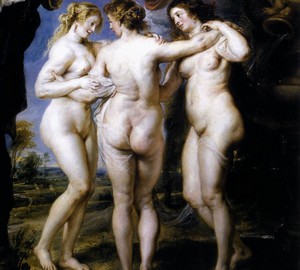Three graces, Rubens – description of the painting

Description of the picture:
Three graces – Rubens. 1639. Wood, oil. 221×181
In the 1630s, Rubens departs from the echo of social life and creates in solitude in the castle of Stan. Here arises one of the most recognizable works of the painter – “Three Graces”.
Now the picture does not cease to amaze – the title with content is very spreading for the modern viewer, brought up on the standards of beauty inherent in our time. Meanwhile, the female bodies of Rubens – this is a whole layer for art criticism. The painter always painted the female nature in a straightforward, honest and open manner. His naked bodies are liberated, but not vulgar, erotic, but not vulgar. Rubens believed that the human body is a creation of God and to be embarrassed to portray it means to be ashamed of this creation, which for a religious artist was simply unimaginable.
The heroines of the picture are ancient graces moving in a smooth dance. It is breathtaking, but everyone looking at the canvas can clearly feel how very the painter is delighted with their slightly full bodies. This ecstasy of the creator is so contagious that no matter the canons of beauty exist, the viewer involuntarily begins to enjoy the heroines of the plot. Soft stripes, luxurious gestures, twists full of bliss – all this is a hymn to the beauty of a woman’s body. As an assertion to this, we see woven flowers over the heads of the heroines, who compositionally have something in common with their bodies woven in a dance.
It is clear that the master painted the grace on the left from life – this is Rubens’ second wife Lena Furman. The creator has just married and bathed in a newfound happiness.
Rubens himself was very fond of this picture and did not want to part with it, because the canvas hung in the artist’s house. Only after his death, the painting was put up for sale, and the first buyer was the Spanish ruler Philip IV. So the “Three Graces” were taken to Spain, where they “live” to this day."